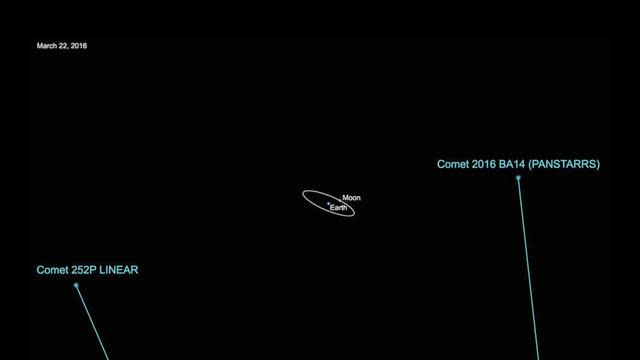'Twin' comets to fly 'remarkably close' to Earth on Monday

Two comets will fly past Earth on Monday 21 and Tuesday 22 March in the third closest comet flyby in recorded history.
NASA says the comets, 252P/LINEAR and P/2016 BA14, may be twins of sorts and will zip past Earth at a range of about 3.3 million miles and 2.2 million miles respectively.
SEE ALSO: Antarctic ice is growing not shrinking, says NASA
SEE ALSO: NASA to market a cure for travel sickness
Comet P/2016 BA14 was discovered by the University of Hawaii's PanSTARRS telescope on January 22 and was initially thought to be an asteroid, but follow-up observations by a University of Maryland and Lowell Observatory team with the Discovery Channel Telescope showed a faint tail revealing that it was a comet.
It follows an unusually similar orbit to that of comet 252P/LINEAR, which was discovered by the Massachusetts Institute of Technology's Lincoln Near Earth Asteroid Research (LINEAR) survey on April 7 2000.
P/2016 BA14 is roughly half the size of comet 252P/LINEAR and might be a fragment that calved off sometime in the larger comet's past.
Paul Chodas, manager of NASA's Center of NEO Studies (CNEOS), said: "Comet P/2016 BA14 is possibly a fragment of 252P/LINEAR. The two could be related because their orbits are so remarkably similar."
It will be the third closest flyby of a comet in recorded history next to comet D/1770 L1 (Lexell) in 1770 and comet C/1983 H1 (IRAS-Araki-Alcock) in 1983.
The time of closest approach for comet 252P/LINEAR on March 21 will be around 5:14 am PDT. The time of closest approach for P/2016 BA14 on March 22 will be around 7:30 am PDT.
NASA says that While both comets will safely fly past at relatively close distances, anyone hoping to see them will need powerful, professional-grade telescopes due to their relatively small size.




